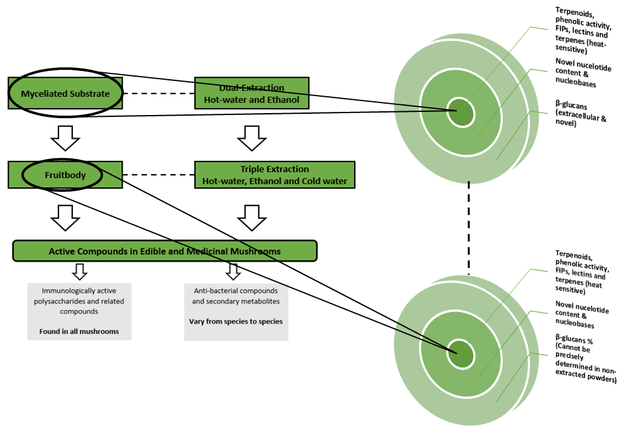The ‘open window’ in stress-induced immunosuppression can present as part of a hypometabolic state that may be beneficial to the host (5, 17-20). Acute stress can induce a beneficial immune trafficking response, while chronic stress can induce a state in which NK cell activity is down-regulated, and pro-inflammatory cytokines are up-regulated beyond the ‘open window’ (5,9).
A patient population that presents a long-term weakened cellular immunity, as well as longer recovery times and abnormalities in metabolic functions, can functionally impair performance and/or recovery, while potentially being synonymous with Chronic Fatigue Syndrome (CFS) (5, 17-20). Activities that require high exertion also require increased metabolism, which at a cellular level, are capable of being pathological, protective, and regulatory depending on the stress response to stimulation, the environment, and length of time (17-20). Despite heterogeneity of factors, some of the underlying cellular responses are highly conserved, which may assist with targeted therapeutic strategies if metabolic states can be recognized by known underlying metabolites (Figure 1 in Part 1) (2, 17-20).
Factors such as adenosine depletion is an aspect in immunosuppression. Although, whether purine depletion or mTORC1 inhibition follow first, still needs to be determined for immuno-modulatory activity (13). Mechanistically immune-modulation involves mTOR upstream regulators that sense cellular purine status, by which restoration of intracellular adenine via exogenous purines reactivates mTOR and depletion of cellular purines inhibits mTOR (12). Consumption of BCAA’s/AA’s and nucleoside analogues that are sensed upstream (activation of cell membrane receptors) by signal transduction pathways, stimulate nutrient-sensitive and adaptive receptors to signal downstream (production of second messengers after cell membrane activation) where the exogenous nucleotides are a currency, in exchange, for the bioenergetics of sensing total nucleotide abundance in cells and protein synthesis or conversely lysosomal autophagy (13).
Glutamine is one of many currencies to these signal transduction pathways as growing mammalian cells use glutamine as a nitrogen source for TCA cycle metabolites where reactions replenish the TCA cycle intermediates that occur due to the breakdown of glutamine when glucose levels are low to maintain TCA cycle energy production. BCAA’s, glutamine and glutamic acid are abundant in edible mushroom protein content and needed for human physiological functions (6, 13). Therefore, once the tough chitinous cellular walls of Fungi are thoroughly broken down they provide BCAAs to regulate mTOR-mediated protein, regulate and activate cytokines, as well as modulate the uptake of glutamine and glutamic acid for chitinase activation (6, 11, 12, 15). If extracted products are incorporated, then the presence of heavier molecular weight β-glucans and secondary metabolites for immuno-modulatory and immuno-stimulatory activity via Dectin-1 cascades are acquired (See Part 1 & Figure 4).

Figure 4. Supplementation levels (Data cited in Ref. 10 in Part 1)
However, quality in fungi products is based on different measurements between species, powders vs extracts and fruitbody vs mycelium-based products (Figures 4 and 5). There are no unambiguous rules to grade mushroom product quality. Mycelium is the actual living organism, while the fruitbody is a reproductive structure that produces spores to continue the life cycle (Figure 3 in Part 1). Cultivating mushrooms commercially is not an easy undertaking. If medicinal species are grown, it becomes even more complex. Some species can take up to three months to harvest and have a range of quality measurements, scaling to genomics-assisted breeding. If quality measurements are not in place, your supplier obviously cannot qualitatively/quantitatively ensure good manufacturing practices.
The extractions and methodologies used set apart the bioactivity of the final product (Figures 3 in Part 1 and 5) (14, 15). β-glucan can exist as polysaccharide-protein complexes, having an assortment of proteins and sugars that are needed to fully activate immune cascades (4,14). Ethanol extraction is needed to obtain most of these protein compounds. The inhibitory and antioxidant activities can be significantly lower in hot water extracts than cold water extracts (6,16). Cold-water extraction before hot-water or ethanol extraction can yield higher antioxidant and stronger inhibitory activity than singular extracts (15, 16). For other immuno-modulatory compounds in fungi see Figure 5, of which many are water-insoluble or non-combustible (14). Thus, quality measurements depend on the type of product. Although an under-recognized measurement of mushroom extractions in all species is nucleoside content, as this content is what gives edible fungi their distinct umami (savory taste) flavor (12).
To conclude, the difference in bio-active ingredients make characterizing product quality not a singular reference or microparticulate aspect of β-glucan percentage, nucleotide content, or phenolic activity, however these do provide certainty to the practitioner/consumer. Key differentiators in this rapidly growing industry will be the company’s product acquisition or development methods. Due to the lack of regulation, knowing your supplier and the methods they have in place are essential for the quality and safety of consumption of mushrooms and related products.
Note: As some fungi display an incredible ability to bio-remediate (process used to treat contaminated media) heavy metals/toxic molecules, therefore finding 100% organic products is crucial.

Figure 5. Mushroom Life Cycle and Potential Quality Measurements
Quantifying product nucleoside content will become an aspect of importance as mycelium in some species have richer 5’nucleotides content than in the respective fruiting bodies (12).
(Utilized infomation in the illustration cited in Ref. 10 in Part 1)
References:
- Geng P et al (2017). Antifatigue Functions and Mechanisms of Edible and Medicinal Mushrooms. Biomed Res Int. 2017: 9648496.
- Phan CW et al (2017). A review on the nucleic acid constituents in mushrooms: nucleobases, nucleosides, and nucleotides. Critical Reviews in Biotechnology.
- Hoxhaj G (2017). The mTORC1 signaling network senses changes in cellular purine nucleotide levels. Cell Rep. 21(5):1331–1346.
- Elder M et al (2017). β-Glucan Size Controls Dectin-1-Mediated Immune Responses in Human Dendritic Cells by Regulating IL-1β Production. Front Immunol. 8:791.
- Zhu F et al (2015). Beta-glucans from edible and medicinal mushrooms: Characteristics, physicochemical and biological activities. Journal of Food Composition and Analysis. 41:165-173.
- Chen P et al (2016). Extraction temperature affects the activities of antioxidation, carbohydrate-digestion enzymes, and angiotensin-converting enzyme of Pleurotuscitrinopileatus extract. Journal of Food and Drug Analysis. 24(3):548-555. [online].
- Campbell J & Turner J (2018). Debunking the Myth of Exercise-Induced Immune Suppression: Redefining the Impact of Exercise on Immunological Health Across the Lifespan. Front Immunol. 9:648.
- Naviauz R et al (2017). Metabolic features of chronic fatigue syndrome. PNAS. 113(37):E5472-E5480.
- Vogt H et al (2016).Metabolic features of chronic fatigue syndrome revisited. Proc Natl Acad Sci U S A. 113(46):E7140-E7141.
- Naviaux R et al (2016). Reply to Vogt et al: Metabolomics and chronic fatigue syndrome. Proc Natl Acad Sci U S A. 113(46):E7142-E7143.
Bibliography
Fungimag.com and Robert Dale Rogers, 2016. Mushrooms Vs. Mycelium: Choosing the Best Medicinal. [online] [pdf].
Grand View Research, 2018. Report Summary. Mushroom Market Analysis, Market Size, Application Analysis, Regional
Outlook, Competitive Strategies, and Forecasts, 2015 To 2022. [online].
Mushroomreferences.com, 2018. Home. [online].
Apologies to all, there are formatting errors I did not pick up on the reference list. The starting reference should be 11 and final reference 20, as follows:
11 Geng P et al (2017). Antifatigue Functions and Mechanisms of Edible and Medicinal Mushrooms. Biomed Res Int. 2017: 9648496.
12 Phan CW et al (2017). A review on the nucleic acid constituents in mushrooms: nucleobases, nucleosides, and nucleotides. Critical Reviews in Biotechnology.
13 Hoxhaj G (2017). The mTORC1 signaling network senses changes in cellular purine nucleotide levels. Cell Rep. 21(5):1331–1346.
14 Elder M et al (2017). β-Glucan Size Controls Dectin-1-Mediated Immune Responses in Human Dendritic Cells by Regulating IL-1β Production. Front Immunol. 8:791.
15 Zhu F et al (2015). Beta-glucans from edible and medicinal mushrooms: Characteristics, physicochemical and biological activities. Journal of Food Composition and Analysis. 41:165-173.
16 Chen P et al (2016). Extraction temperature affects the activities of antioxidation, carbohydrate-digestion enzymes, and angiotensin-converting enzyme of Pleurotuscitrinopileatus extract. Journal of Food and Drug Analysis. 24(3):548-555. [online].
17 Campbell J & Turner J (2018). Debunking the Myth of Exercise-Induced Immune Suppression: Redefining the Impact of Exercise on Immunological Health Across the Lifespan. Front Immunol. 9:648.
18 Naviauz R et al (2017). Metabolic features of chronic fatigue syndrome. PNAS. 113(37):E5472-E5480.
19 Vogt H et al (2016).Metabolic features of chronic fatigue syndrome revisited. Proc Natl Acad Sci U S A. 113(46):E7140-E7141.
20 Naviaux R et al (2016). Reply to Vogt et al: Metabolomics and chronic fatigue syndrome. Proc Natl Acad Sci U S A. 113(46):E7142-E7143.
Apologies this was not picked up and edited in the 7 day window. Please allow this to serve as an error correction for the list.
All references before 11 can be found in Part 1 on my blog.
Thanks,
Downvoting a post can decrease pending rewards and make it less visible. Common reasons:
Submit
Congratulations @ricatsteem! You have completed the following achievement on Steemit and have been rewarded with new badge(s) :
Click on the badge to view your Board of Honor.
If you no longer want to receive notifications, reply to this comment with the word
STOPDownvoting a post can decrease pending rewards and make it less visible. Common reasons:
Submit
Congratulations @ricatsteem! You have completed the following achievement on Steemit and have been rewarded with new badge(s) :
Click on the badge to view your Board of Honor.
If you no longer want to receive notifications, reply to this comment with the word
STOPTo support your work, I also upvoted your post!
Downvoting a post can decrease pending rewards and make it less visible. Common reasons:
Submit
Congratulations @ricatsteem! You received a personal award!
You can view your badges on your Steem Board and compare to others on the Steem Ranking
Vote for @Steemitboard as a witness to get one more award and increased upvotes!
Downvoting a post can decrease pending rewards and make it less visible. Common reasons:
Submit